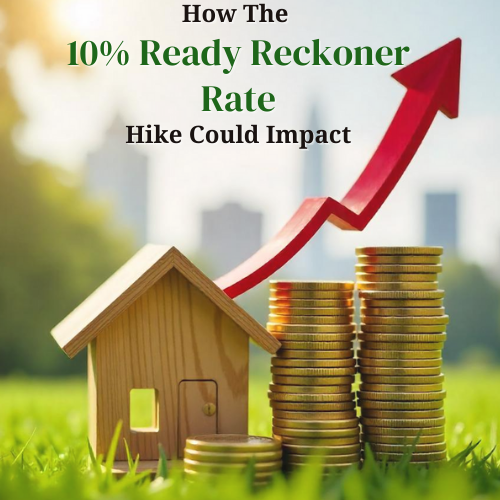How the 10% Ready Reckoner Rate Hike Could Impact
The Maharashtra government has made an announcement regarding 10% increase in the Ready Reckoner Rates which will be implemented from 1st April 2025. The main aim of this hike is to boost up state revenue, as till now it is under pressure. Although this hike will bolster additional funds, it will impose certain implications on home buyers, and the real estate developers at large.
What is meant by ready reckoner rates?
Ready reckoner rates or often known as circle rates in some regions indicate the benchmark set by state government for minimum property value on stamp duty and registration purposes. These rates ensure that the registration value of the property reflects its market worth. This rate depends on the factors like property location, infrastructure development and market trends.
The proposed 10% hike
The Maharashtra government has declared 10% increase in RR rates, and this rate is schedule to be implemented from 1st April 2025. This move comes under the strategy of enhancing revenue collection, as it is the current concern of the state. Earlier the RR was revised in 2022, and this frequent hike showcases the government’s response on evolving economic landscape.
Why there is need to increase Ready Reckoner Rate by 10%
There are various factors associated with this increase, let’s have a discussion on them in detail:
Inflation and market dynamics: The current economy of Maharashtra is under immense pressure for various sectors. This is due to increase in price of construction material, land and labor. With the increase in RR rate the aim of government is to align the property tax base with this rising cost. With the rise of cost of living and construction, the government will use this increased RR rate amount to improve market condition and ensure that property tax remains proportionate.
Urbanization and infrastructure development: With the expansion of each city in Maharashtra and the development of infrastructure projects like metro systems, roads and airports, the properties present in the vicinity tend to appreciate with time. Hence government will increase RR rate to show the increased desirability of these areas, resulting in higher cost of properties.
Government revenue needs: The demand of improved healthcare and public infrastructure has compelled government to increase RR rate to meet the need. The increase in RR rate will increase state and municipal revenue in the form of higher property tax; this can be used to fulfill the need of such projects.
Economic Recovery Post-pandemic: In various parts of the world, pandemic has badly impacted the economy. As economies recover, government wants to stabilize the finances by taking extra capital through property tax rates. This hike in RR could be the part of this recovery strategy, to ensure that government can meet the fiscal needs post-pandemic.
Implications for property buyers
Increased property costs: This hike in RR will result in higher stamp duty and registration charges for property buyers. This will make the properties more expensive and can have an impact on the affordability of home for many buyers.
Potential slowdown in transactions: The price rise will make the buyers reluctant to buy a property and this will slowdown the property registrations. The overall increase in RR will impact the liquidity of real estate market and will delay property deals.
Implications for developers
Hike in project cost: From April, developers are supposed to pay premium along with other taxes as per Ready Reckoner Rate to get the construction permission. This will enhance the overall development project cost.
Pricing strategies: To get the desired profit margin, developers may change their pricing strategies and this will end up with higher prices for end customers. This will affect the competitiveness of developers in the market.
Impact on new projects: The rise in price will impact the developers’ decision of launching new projects, especially in underrated and saturated areas.
Government’s perspective
For Maharashtra government, this step can prove to be a boon to increase state revenue which is currently not in good state due to implementation of schemes like ‘Ladki Bahin’. Increase in Ready Reckoner Rate will generate extra income for the government which will be around Rs. 15,000 cr to Rs. 20,000 cr, supplementing the current revenue coming from stamp duty and registration fees.
The overall impact on the real estate market
Decrease in real estate transactions
With the increase in property prices, the overall volume of transactions in real estate market will decrease. The potential buyers may postpone their decision of buying a property, with a hope that prices will stabilize in coming years.
Both buyers and sellers need to compromise on their expectations. Buyers will focus on the areas which are still affordable and sellers will hold the property to get better prices in future. In such condition, Bavdhan is the ideal location for future homebuyers, as here they may get affordable homes as compared to other places of Pune. The high tax imposition will also minimize the overall liquidity of the market. Sellers may not be ready to reduce their asking prices while buyers will be reluctant to commit due to greater capital involved. This will increase the duration of selling cycles resulting in quick price appreciation in coming years.
Impact on commercial real estate
Commercial business owners with office buildings, industrial properties, or retail spaces will face higher taxes which will compel them to increase the rental value of their property. Higher rent may result in higher operational cost. This will impact businesses with thin profit margin, resulting in business closure or slowdown in growth.
Conclusion
The increase in RR rate will significantly impact the real estate market affecting transactions, property taxes, and investment planning. Although initially there will be a pressure on investors, developers and property owners due to higher taxes, but in long run they can avail benefits of improved infrastructure and development in various areas. However, the main challenge is that the rise in tax should not lead to major affordability issues to lower-income families and business persons.





